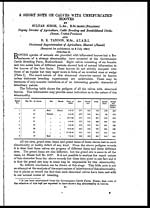Medicine - Veterinary > Veterinary colleges and laboratories > Indian journal of veterinary science and animal husbandry > Volume 12, 1942 > Original articles > Cattle of India and their development
(72) Page 62
Download files
Individual page:
Thumbnail gallery: Grid view | List view

SELECTED ARTICLES
THE CATTLE OF INDIA AND THEIR DEVELOPMENT
BY
F. WARE, C.I.E., F.R.C.V.S., F.N.I., I.V.S.
Animal Husbandry Commissioner with the Government of India
(With plates III-VIII)
(Reprinted from The Empire Journal of Experimental Agriculture, Vol. IX, No. 33, January
1941)
INTRODUCTION
WHEN making a public presentation of two stud bulls for the improve-
ment of cattle in Delhi Province, H. E. the Marquess of Linlithgow, the
Viceroy of India and previously Chairman of the Royal Commission on Agri-
culture in India, observed that' the cow and the working bullock bear on their
patient backs the whole structure of Indian agriculture '. This remark puts
in a nutshell the great importance of cattle to Indian economy. India is a vast
agricultural country with a human population of 350 million people, 90 per
cent of whom live on agriculture. The bullock is almost the only source of
power available for carrying out the various agricultural operations extending
over an area of about 300 million acres of cultivation, besides acting as the major
road-transport animal. Most of the peoples are vegetarian and depend en-
tirely on milk and milk products as the source of animal protein in their diets.
The social and economic importance of cattle to India is therefore self-evident.
The actual as well as the potential value of India's cattle industry is huge
even in its present undeveloped state. The annual value of milk and milk
products is by a conservative estimate not less than Rs. 300 crores (£225
million). The output of hides and skins, of which India is the largest exporter
in the British Empire, is annually worth about Rs. 40 crores. Cattle labour is
variously estimated to be worth between Rs. 300 and Rs. 500 crores annually,
whilst the cash value of their manure, which may be used either for increas-
ing soil fertility or as fuel, is about Rs. 270 crores.
With such an enormous potential value, the question of developing this
industry has naturally received attention, and a reference to the background
of the problem may enable the reader to appreciate the difficulties in the way
of rapid large-scale improvements in India.
First, the number of cattle in India is far too great for the fodder resources
of the country. The area of cultivated land available per head of bovine
population is 1.8 acres, as compared with 3.4 acres in Great Britain, 4.5 in
New Zealand, 31.4 in Canada, and 24.9 in U. S. A. The Royal Commission
on Agriculture estimated that for every 100 acres of net sown area there are 21
acres fallow, 92 acres of grazing, and 20 bullocks, 17 cows, 16 other cattle, 3
male buffaloes, 3 female buffaloes, 5 young buffaloes, and 27 sheep and goats.
This shows the pressure on the land and the acute nature of the fodder prob-
lem. Over wide areas concentrates are fed only to transport ponies and
bullocks and to milch buffaloes, the remainder of the live stock of a village
having to depend on what roughage they can pick up. The grazing land is
very poor after the monsoon, i.e. for most of the year, and in many localities
62
Set display mode to: Large image | Zoom image | Transcription
Images and transcriptions on this page, including medium image downloads, may be used under the Creative Commons Attribution 4.0 International Licence unless otherwise stated. ![]()
| Permanent URL | https://digital.nls.uk/75259301 |
|---|
| Description | Covers articles from 1942. |
|---|




